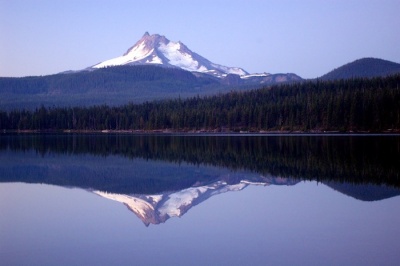Olallie Lake
From Oregon Hikers Field Guide
- Hikes to this location:
- Hikes including this location:
- Olallie North Loop Hike (TH | <— —> | LOG)
- Weather forecast: NWS/NOAA
- Maps: Oregon Hikers Maps Google Maps
- Latitude, Longitude: 44.80717, -121.78697
- Elevation: 4936 feet
Description
Olallie Lake, at 240 acres, is by far the largest lake in the Olallie Lake Scenic Area. The lake is almost 50 feet deep, but the shoreline is very shallow. The lake hosts several campgrounds as well as the Olallie Lake Resort on its shores. The resort has a small store. The old guard station cabin can also be rented.
Olallie Lake is stocked with rainbow and brook trout. Non-motorized craft are allowed on the waters, but swimming and bathing are not permitted (The lake is the source for local drinking water). Do not let your dog swim in the lake.
As with the other lakes on this plateau, Olallie Lake fills a shallow depression created by montane ice sheet glaciation. A layer of glacial silt drapes the whole plateau. Mill Creek is the outlet stream for the lake. There is a small earth dam on the creek. This helps to keep the lake waters at a constant level.
The word olallie is Chinook jargon for 'huckleberry.' Late summer is a good time to harvest the berries here, especially all along the lake's eastern shore.
Links
- Olallie Lake (Jefferson County) (Atlas of Oregon Lakes)
- Olallie Lake (Cascade Ramblings)
- Olallie Lake Guard Station Cabin (Recreation.gov)
- Olallie Lake Resort
- Olallie Lake Resort (USFS)
- 8/20 & 21 Eclipse day at Ollie Lake (Oregon Hikers)
Contributors
- bobcat (creator)



